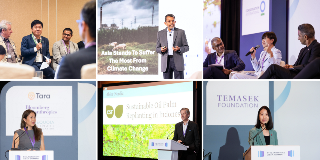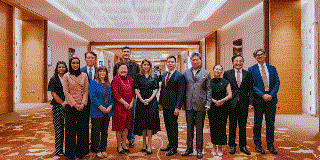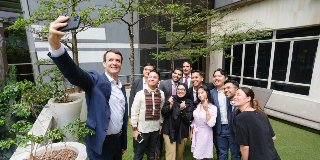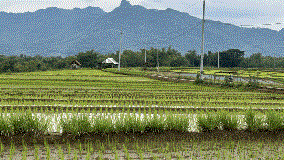Jointly written by:
Laurience Lien, Co-Founder and founding CEO, Asia Philanthropy Circle
Helen Mountford, President and CEO, ClimateWorks Foundation
Lim Seok Hui, CEO, Philanthropy Asia Alliance
Asia has a rich tradition of giving, deeply rooted in cultural values of trust, personal relationships, and legacy. This enduring spirit of philanthropy, long embedded in families and communities, is evolving to address broader societal challenges. Amongst these, the climate crisis looms largest.
Today, Asia sits at a pivotal moment. As the region faces mounting climate threats – from rising sea levels to increasingly destructive storms – the growing philanthropic sector holds tremendous potential to drive impactful, localised climate solutions. Philanthropy plays a critical role in catalysing change by unlocking other forms of capital, fostering innovation across policy, technology, and systems, and supporting bold, long-term solutions that drive systemic impact.
The stakes are immense. With global temperatures projected to rise by 2.6-3.1°C this century, Asia’s vulnerabilities to climate change are starkly evident. Recent storms in Southeast Asia, such as those in the Philippines, Vietnam, and Thailand, have disrupted power grids, supply chains, and livelihoods – clearly laying out the social and economic consequences of inaction. Addressing the climate crisis is no longer optional; it is an urgent necessity.
Encouragingly, movements within Asia’s philanthropic community are gaining momentum, channeling increasing resources to scale climate solutions. Organisations like Asia Philanthropy Circle (APC) and the Philanthropy Asia Alliance (PAA) are driving collaboration across the wealthy to tackle challenges unique to the region, from sustainable urbanisation to biodiversity preservation.
At a roundtable hosted by APC, PAA and ClimateWorks Foundation during Climate Week NYC in September 2024, philanthropic leaders underscored the importance of strategic, targeted investments – or ‘acupuncture points’ – that can trigger outsized impact. By targeting areas with the greatest potential for systemic change, philanthropy can accelerate solutions where they are most needed.
The power of ecosystem: building and collaboration capital for impact
Harnessing these acupuncture points requires building ecosystems for collaboration. Philanthropy is uniquely placed to create synergies across sectors, foster partnerships, and scale localised solutions more effectively.
Kathlyn Tan, Director at Singapore-based Rumah Foundation, embodies this approach. Inspired by her father and her love for the sea, she has led ocean conservation efforts since 2017. Her initiatives range from investing in clean technology to reduce marine debris, to supporting the development of alternative seafood to combat overfishing.
Most recently, Rumah Foundation launched the 30×30 Southeast Asia Ocean Fund alongside Oceankind and the Asia Community Foundation. This collaborative fund supports initiatives that contribute to protecting 30 per cent of the region’s seas by 2030 – the first initiative of its kind in Southeast Asia.
Such examples highlight how a new generation of philanthropists is adopting innovative, collaborative strategies to address climate challenges. By embracing cross-sectoral partnerships, sustainability, and novel strategies, these leaders are forging a new path to long-term impact. Equipping the next wave of philanthropists with tools and networks they need will be critical to sustaining progress.
Broadening capital for impact
Besides driving collaboration, this new wave of philanthropists in Asia is evolving their approach to funding climate action. Moving beyond traditional donations, many are adopting portfolio-based approaches that integrate grants, debt, and equity to unlock a broader range of solutions.
In India, Mirik Gogri of Spectrum Impact has led philanthropy efforts in sync with globally required interventions. His work tackles complex challenges by blending diverse forms of capital with cross-sector solutions. This approach reflects a broader trend growing across Asia, where philanthropists increasingly view their resources as catalysts for systemic, sustainable change.
Growing global support for Asia's climate action
While Asia’s climate philanthropy grows, global support remains crucial. According to the ClimateWorks Foundation’s Funding Trends Report, foundation funding for climate change mitigation disproportionately favoured Europe ($2.05 billion) and the United States ($5.2 billion) from 2019 to 2023. Together, these regions received more than 60 per cent of foundation funding that was directed to a specific region or country during this period, leaving Asia with a significantly smaller share.
However, this is shifting – with Asia’s share increasing in recent years as global funders recognise the region’s increasing importance in mitigating the climate crisis. Organisations such as the Children’s Investment Fund Foundation (CIFF), ClimateWorks Foundation, and Growald Climate Fund are now forging partnerships with Asia-based groups such as Solutions For Our Climate, Tara Climate Foundation, and Viriya ENB. Such collaborations are vital to accelerating climate action in the region, particularly in Southeast Asia, where solutions often require nuanced, localised approaches.
Leveraging public-private-philanthropic partnerships (PPPPs)
Another promising avenue for driving solutions lies in public-private-philanthropic partnerships (PPPPs). By combining philanthropy’s appetite for risk-taking and innovation, the public sector’s regulatory support and credibility, and the private sector’s technological expertise and focus on financial sustainability, PPPPs can collectively drive transformative change.
For instance, a project in Cambodia involving the Wildfowl and Wetland Trust, the International Union for Conservation of Nature, and local communities has reduced chemical fertiliser use by 15 per cent and introduced drought-tolerant crops, all while protecting local wildlife. The reduction of chemical fertilisers, which are reliant on fossil fuels for production, enhances soil health and cuts a significant source of climate pollution. Such models demonstrate the potential for scalable, climate-resilient solutions tailored to local contexts.
Scaling action in climate philanthropy
To maximise impact, philanthropy in Asia must address foundational gaps – such as developing green talent, data infrastructure, and mobilising new funders. A recent joint report by ClimateWorks Foundation, PAA, and the World Economic Forum identified these areas as critical ‘acupuncture points’ for systemic change.
Investing in green talent, for example, can build the workforce necessary to accelerate climate action in the region. Similarly, improving data collection and impact measurement can enhance transparency and enable better, informed decision-making by philanthropists. Finally, mobilising new funders, supported by expert networks, will ensure a steady flow of resources towards high-impact initiatives.
A catalyst for lasting change
The complexity of the climate crisis can be daunting, but it also presents fertile ground for innovation and collaboration. In Asia, climate challenges often intersect with a multitude of other issues, which demand local solutions supported by cross-sector partnerships. Philanthropists have a pivotal role to play – by investing in research, building institutions and capacity, and fostering collaboration, they can help shape a flourishing future for all.
Bold action is needed now. Together, we can empower communities, accelerate solutions, and change our planet’s trajectory for the better.
This article was originally published in Alliance Magazine on 12 February 2025.

.jpg?sfvrsn=fedc60fc_1)







.tmb-.png?Culture=en&sfvrsn=7fea9931_1)


.tmb-.gif?Culture=en&sfvrsn=e13997ec_1)





.tmb-.gif?Culture=en&sfvrsn=3f4b1163_1)






.tmb-.gif?Culture=en&sfvrsn=b5ece239_1)
.tmb-.gif?Culture=en&sfvrsn=6fb3b6df_1)



